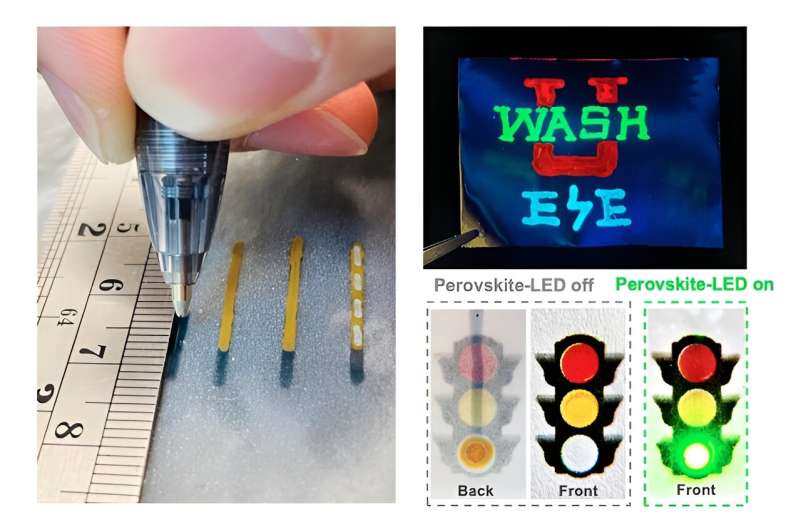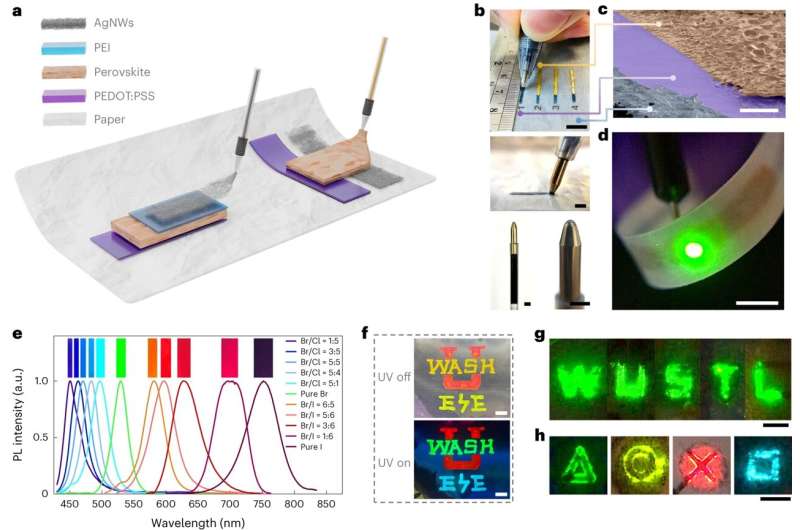This article has been reviewed according to Science X's editorial process and policies. Editors have highlighted the following attributes while ensuring the content's credibility:
fact-checked
peer-reviewed publication
trusted source
proofread
Simple ballpoint pen can write custom LEDs

The invention of the printing press revolutionized duplication of the written word, giving the hands of tired scribes a break and making written material more accessible. A similar breakthrough has happened in reverse in the McKelvey School of Engineering at Washington University in St. Louis.
Researchers working with Chuan Wang, associate professor of electrical & systems engineering, have developed ink pens that allow individuals to handwrite flexible, stretchable optoelectronic devices on everyday materials including paper, textiles, rubber, plastics and 3D objects. Flexible optoelectronics for emitting and detecting light, which are already found in everyday objects like smartphones and fitness trackers, can bend, fold and flex while maintaining functionality.
In a paper published in Nature Photonics, the team reports their simple and versatile fabrication approach to allow anyone to make a custom light-emitting diode (LED) or photodetector without the need for any specialized training or bulky equipment. The new handheld fabrication technology builds on earlier work by Wang and first author Junyi Zhao, a doctoral candidate in Wang's lab, in which they demonstrated a novel way to fabricate stretchable LEDs with a simple inkjet printer.
"Handwriting custom devices was a clear next step after the printer," Wang said. "We had the inks already, so it was a natural transition to take the technology we had already developed and modify it to work in regular ballpoint pens where it could be cheap and accessible to all."

The team's environmentally friendly, innovative handwriting approach empowers individuals to create multicolor LEDs and photodetectors in mere minutes. The technology harnesses the simplicity of a ballpoint pen, filled with specially designed inks made of conductive polymers, metal nanowires and crystalline materials called perovskites to generate a wide spectrum of emission colors.
By writing layer upon layer with these functional inks, much like using multicolored pens, a variety of functional devices including disposable electronics, such as smart packaging, and personalized wearables, such as biomedical sensors, can be created cheaply, easily and quickly.
Though the team had already developed printable ink, translating it for standard ballpoint pens that are feasible for handwriting on everyday materials required a few tweaks to control wettability and improve writability. Most importantly, Zhao had to make sure the ink could be applied to porous and fibrous substrates, including paper and textiles, without running or mixing. Beyond avoiding the aesthetic disappointment of a smudged design, the layers must remain discrete to ensure functional, high-performance optoelectronic devices.
"The translation from printer to ballpoint pen might look simple, but it's actually a bit trickier than just loading ink," Zhao said.
"Our ink is specially formulated, so the pens are universal, meaning they'll work on almost all substrates. Each single layer of the device is designed to be intrinsically elastic so it will survive deformation and can be bent, stretched and twisted without impacting device performance. For example, LEDs drawn on a glove could tolerate deformations from repeated fist grasping and releasing, and LEDs drawn on a rubber balloon could survive inflation-deflation cycles over and over."
The creation of ink pens that work on all substrates from paper to party balloons overcomes critical limitations of traditional LED fabrication—particularly the requirement of flat, smooth substrates and cost-prohibitive clean-room fabrication equipment—and opens the door for next-generation wearable electronics to permeate daily life in an unprecedented way.
Wang envisions future applications for handwritten electronics limited only by the user's imagination. Immediate uses range from educational purposes and science popularization to electronic packaging and clothing to medical sensors and bandages.
"Cheap, customizable LEDs open up opportunities for hands-on education, more vivid textiles like light-up clothing or greeting cards, and smart packaging," Wang said. "One area we're really excited about is medical applications. Handwritten light emitters and detectors allow more patient-specific flexibility in creating wearable biomedical sensors and bandages that could have photodetectors and infrared LEDs drawn onto them for measuring pulse oximetry or to speed wound healing."
The accessibility and flexibility of this method could democratize electronic manufacturing, allowing the possibility of customized, stretchable electronic devices to become part of the fabric of everyday life, the researchers said.
More information: Junyi Zhao et al, Handwriting of perovskite optoelectronic devices on diverse substrates, Nature Photonics (2023). DOI: 10.1038/s41566-023-01266-1
Journal information: Nature Photonics
Provided by Washington University in St. Louis




















